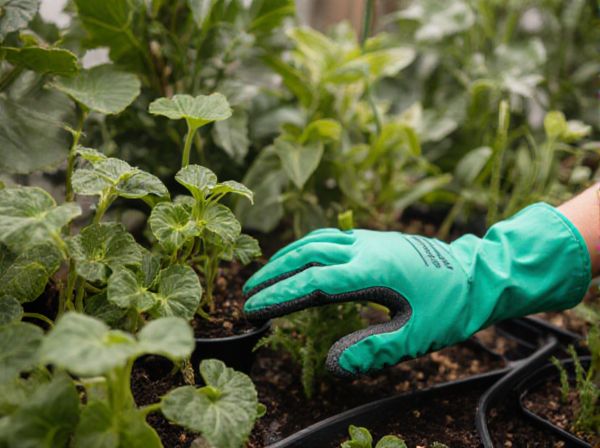
Humidity-Loving Plants vs Arid-Loving Plants Illustration
Humidity-loving plants thrive in moist environments with consistent water availability, developing broad leaves to maximize transpiration and nutrient absorption. Arid-loving plants have adapted to dry conditions by minimizing leaf surface area and storing water in specialized tissues, often exhibiting thick cuticles and deep root systems to conserve moisture. Understanding these adaptations helps optimize plant care and landscape planning based on specific climate conditions.
Table of Comparison
| Feature | Humidity-Loving Plants | Arid-Loving Plants |
|---|---|---|
| Preferred Climate | High humidity, tropical or subtropical | Low humidity, dry desert or semi-arid |
| Water Requirements | Frequent watering; thrive in moist soil | Minimal watering; adapted to drought conditions |
| Leaf Characteristics | Broad, thin leaves for transpiration | Thick, waxy, or spiny leaves to reduce water loss |
| Root System | Shallow but wide to capture surface moisture | Deep roots to access underground water |
| Examples | Ferns, orchids, peace lilies | Cacti, succulents, agave |
Understanding Humidity-Loving Plants
Humidity-loving plants, such as ferns, orchids, and peace lilies, thrive in environments with consistently high moisture levels, benefiting from relative humidity typically above 60%. These plants have adapted to absorb water efficiently through their leaves and roots, enabling optimal growth in tropical and subtropical climates. Maintaining adequate humidity is crucial for their physiological processes, including photosynthesis and transpiration, which directly influence their health and vitality.
Characteristics of Arid-Loving Plants
Arid-loving plants exhibit adaptations such as thick, waxy cuticles that minimize water loss and deep root systems designed to access underground moisture. These plants often have reduced leaf surface areas or spines to decrease transpiration and protect against herbivory, enabling survival in desert and dry environments. Their physiological mechanisms include CAM photosynthesis, which optimizes water use efficiency by opening stomata at night to reduce evaporation.
Adaptations for High-Humidity Environments
Humidity-loving plants exhibit adaptations such as broad, thin leaves with drip tips to facilitate water runoff and prevent fungal growth in moist environments. They often possess stomata located on the underside of leaves to regulate transpiration effectively under high humidity. These plants also develop shallow root systems to maximize water uptake from the consistently moist soil typical of humid habitats.
Drought-Resistant Features of Arid Plants
Arid-loving plants exhibit advanced drought-resistant features such as thick, waxy cuticles, deep root systems, and the ability to store water in specialized tissues, enabling survival in extreme dry conditions. Unlike humidity-loving plants that thrive in moist environments, these adaptations minimize water loss and maximize water absorption during rare rain events. Specialized photosynthetic processes like CAM (Crassulacean Acid Metabolism) further enhance water efficiency, making arid plants highly resilient to prolonged droughts.
Popular Humidity-Loving Plant Varieties
Popular humidity-loving plant varieties include ferns, orchids, and peace lilies, which thrive in moist environments due to their adaptation to high humidity levels. These plants possess specialized structures such as waxy leaves or aerial roots that help them absorb and retain moisture effectively. In contrast to arid-loving plants like cacti and succulents, humidity-loving species require consistently damp soil and ambient moisture for optimal growth and photosynthesis.
Top Choices for Arid-Loving Gardens
Top choices for arid-loving gardens include succulents like agave, echeveria, and aloe vera, which thrive in low-humidity, dry environments due to their water-storing capabilities. Cacti such as saguaro and barrel cactus are also ideal, as they have adapted to conserve moisture and withstand intense heat. These plants not only withstand drought but also enhance xeriscaping efforts by requiring minimal irrigation and maintenance.
Soil and Watering Needs: Moist vs. Dry
Humidity-loving plants thrive in moist, well-draining soils that retain consistent hydration, requiring frequent watering to maintain optimal growth. In contrast, arid-loving plants prefer dry, sandy or rocky soils with excellent drainage, minimizing water retention and necessitating infrequent watering to prevent root rot. Proper soil composition and watering schedules tailored to these moisture preferences are crucial for the survival and health of these distinct plant types.
Sunlight Requirements for Both Plant Types
Humidity-loving plants thrive in indirect, filtered sunlight as direct exposure can cause leaf scorching, while arid-loving plants require intense, direct sunlight to mimic their native desert environments and optimize photosynthesis. The sunlight needs of humidity-loving species like ferns and philodendrons support their moisture-retaining adaptations, whereas cacti and succulents depend on strong sunlight to regulate water storage and growth cycles. Understanding these distinct sunlight requirements helps maintain plant health and promotes optimal growth based on their natural climate adaptations.
Common Climate Challenges and Solutions
Humidity-loving plants thrive in moist environments but often face challenges such as fungal diseases and root rot caused by excessive moisture. Arid-loving plants are adapted to dry climates but struggle with water scarcity and extreme temperature fluctuations, requiring efficient water storage and heat tolerance. Effective solutions include optimizing irrigation techniques for humidity-loving plants to prevent overwatering and using drought-resistant species with deep root systems in arid regions to enhance survival under harsh conditions.
Designing a Garden: Combining Humidity and Arid Plants
Designing a garden that combines humidity-loving plants like ferns, orchids, and calatheas with arid-loving plants such as succulents, cacti, and agaves requires strategic zoning and soil management. Use microclimates and raised beds to separate moisture-retentive, organic-rich areas from well-draining, sandy or rocky sections, ensuring each plant type thrives in its preferred environment. Efficient irrigation systems and mulching tailored to humidity and drought conditions help maintain optimal moisture levels and promote healthy growth for both plant groups.
Humidity-Loving Plants vs Arid-Loving Plants Infographic

 gardendif.com
gardendif.com